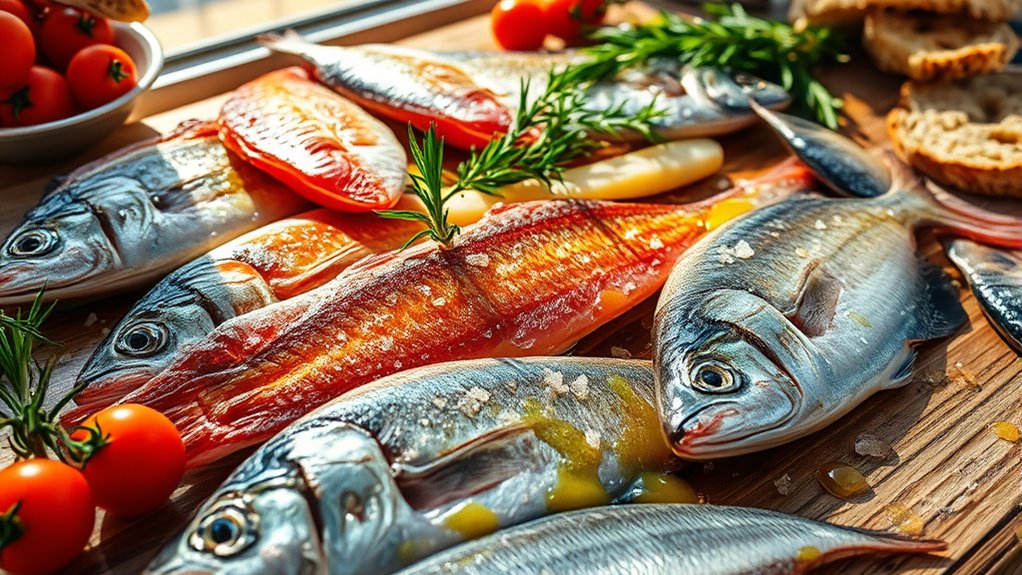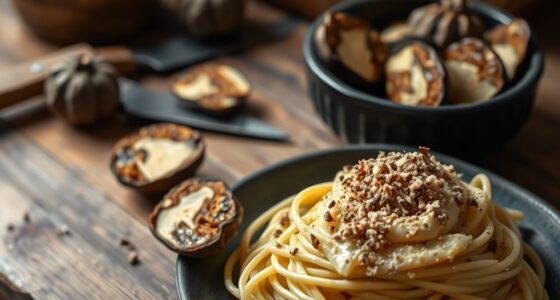In Italian coastal cuisine, seasonal fish play a key role, changing throughout the year to reflect local traditions and sustainable fishing practices. In spring, you’ll find fresh branzino, while summer offers lighter options like sardines and anchovies. Autumn features richer varieties like monkfish and cod. These seasonal choices guarantee peak flavor and freshness, helping preserve Italy’s culinary heritage and marine ecosystems. Continue exploring to discover how each season’s fish shapes authentic coastal dishes.
Key Takeaways
- Seasonal fish like branzino in spring, sardines in summer, and monkfish in autumn are central to traditional Italian coastal dishes.
- Italian coastal cuisine emphasizes sustainable fishing methods that protect marine ecosystems and ensure fresh, high-quality seafood.
- Recipes focus on simple preparations that highlight the natural flavors of seasonal fish, using ingredients like lemon, garlic, and herbs.
- Choosing seasonal fish guarantees peak freshness, flavor, and preserves Italy’s culinary heritage rooted in harmony with nature.
- Supporting sustainable seafood practices helps maintain marine biodiversity and preserves Italy’s coastal culinary traditions for future generations.

Italy’s coastal cuisine celebrates the changing seasons by highlighting fresh, local fish at their peak. As you explore the vibrant markets and seaside taverns, you’ll notice how each season brings a new variety of fish, all caught through sustainable fishing practices that protect the ocean’s health. This approach guarantees that the seafood you enjoy isn’t just delicious but also responsibly sourced, allowing you to indulge while supporting environmental conservation. Using sustainable fishing methods helps maintain fish populations and preserves marine ecosystems, which is essential for keeping Italy’s coastal flavors vibrant for generations to come.
Italy’s coastal flavors thrive through seasonal, sustainably caught fish supporting ocean health and culinary tradition.
In traditional recipes passed down through generations, seasonal fish are the star ingredients that define regional dishes. When you cook or order these recipes, you tap into a culinary heritage rooted in respect for nature’s cycles. For instance, in spring, you might savor branzino, a delicate sea bass, prepared simply with herbs and olive oil, embodying the essence of fresh, local produce. Come summer, lighter fish like sardines and anchovies become prominent, often grilled or marinated to highlight their natural flavors. Autumn brings a richer variety, such as monkfish and cod, which lend themselves well to hearty stews and baked dishes. In winter, the focus shifts to robust, firm fish that can stand up to slow cooking, like hake or mackerel.
By choosing seasonal fish, you’re not only enjoying peak freshness and flavor but also embracing a sustainable approach that aligns with Italy’s culinary traditions. Many coastal communities have long relied on traditional recipes that emphasize simple, wholesome ingredients, allowing the natural taste of the fish to shine through. These recipes often involve minimal seasoning—just lemon, garlic, herbs, and olive oil—highlighting the fish’s inherent quality. When you prepare or enjoy these dishes, you participate in a cultural practice that values harmony with nature and respect for local resources.
Furthermore, understanding the importance of sustainable fishing can deepen your appreciation for Italy’s coastal cuisine. It encourages responsible consumption and supports fishermen who adhere to eco-friendly practices. This way, you contribute to maintaining the balance of marine life while savoring authentic flavors rooted in tradition. Additionally, awareness of sustainable fishing practices can help you make informed choices when selecting seafood, ensuring that your enjoyment does not come at the expense of the environment. Whether you’re dining at a seaside trattoria or cooking at home, paying attention to seasonal fish and traditional recipes helps preserve Italy’s rich culinary heritage and the health of its seas.
Frequently Asked Questions
How Are Seasonal Fish Traditionally Prepared in Italy?
You’ll find that seasonal fish in Italy is prepared using traditional recipes and simple cooking techniques that highlight fresh flavors. Typically, you might grill, bake, or lightly fry the fish, often seasoned with herbs, lemon, and olive oil. In many regions, locals prepare fish with minimal fuss, trusting the quality of the ingredients. This approach celebrates the fish’s natural taste, making every dish authentic and delicious.
Which Italian Regions Are Best Known for Seasonal Fish Dishes?
You’ll find that regions like Liguria, Sicily, and Naples are best known for their seasonal fish dishes. These areas showcase regional specialties rooted in rich fishing traditions, emphasizing fresh catches and simple preparations. You’ll enjoy seafood that’s caught locally, often featured in signature dishes like Ligurian anchovies, Sicilian sardines, or Neapolitan calamari. Exploring these regions, you experience authentic flavors that highlight Italy’s coastal culinary heritage.
Are There Specific Festivals Celebrating Seasonal Fish in Italy?
Imagine Italy’s coastal towns as vibrant symphonies, each celebrating its unique melody. You’ll find fish markets bustling with fresh catches, and culinary festivals that honor seasonal fish. These festivals, like Venice’s Sagra del Pesce or Liguria’s Festa di San Nicolò, turn local traditions into lively celebrations. They showcase Italy’s deep respect for seasonal fish, making each bite a harmonious blend of culture, community, and ocean’s bounty.
How Does Seasonal Fishing Impact Local Italian Economies?
You see, seasonal fishing directly impacts local Italian economies by regulating fish quotas, ensuring sustainable catches. When fish are abundant, communities benefit from increased fishing tourism, boosting revenue and employment. Conversely, strict quotas or off-season restrictions can reduce income. By managing fishing seasons wisely, you help preserve marine resources while supporting local livelihoods, making seasonal fishing a crucial part of Italy’s coastal economy.
What Are Sustainable Practices for Sourcing Seasonal Fish in Italy?
Imagine you’re tending a delicate garden; you protect its balance to guarantee growth. Similarly, sustainable fishing practices in Italy focus on marine conservation and setting fishing quotas to prevent overharvesting. By embracing these methods, you help preserve fish populations, maintain ecosystem health, and support local economies. Your responsible choices ensure that future generations can enjoy the richness of Italy’s coastal waters, just like nurturing a treasured garden.
Conclusion
As you savor the flavors of seasonal fish, imagine the Italian coast’s shimmering waters whispering stories of tradition and freshness. Each catch, like a hidden treasure, transforms your plate into a vibrant tapestry of taste and history. Embrace the changing seasons, letting the ocean’s bounty guide your culinary journey. With every bite, you become part of a timeless dance between land and sea, where nature’s rhythm paints your dining experience with unforgettable hues.









